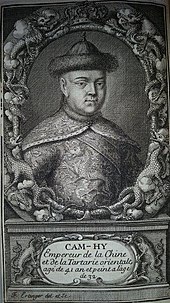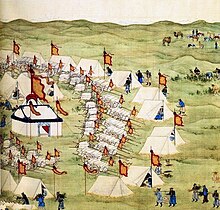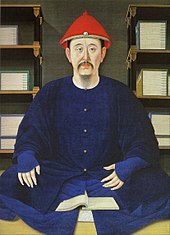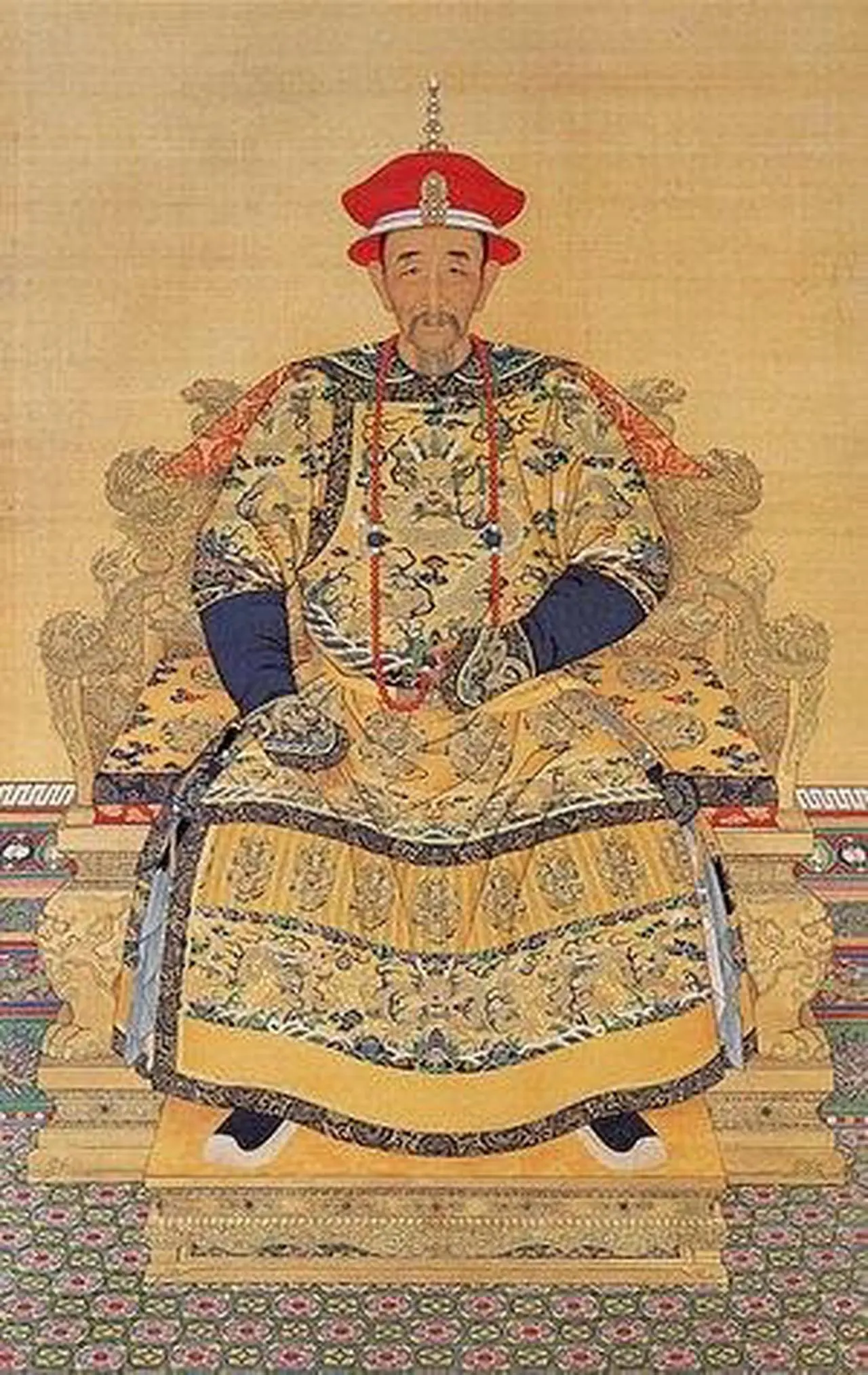The Kangxi Emperor (4 May 1654 – 20 December 1722), also known by his temple name Emperor Shengzu of Qing, personal name Xuanye, was the third emperor of the Qing dynasty, and the second Qing emperor to rule over China proper, reigning from 1661 to 1722.
The Kangxi Emperor's reign of 61 years makes him the longest-reigning emperor in Chinese history (although his grandson, the Qianlong Emperor, had the longest period of de facto power, ascending as an adult and maintaining effective power until his death) and one of the longest-reigning rulers in history.[1] However, since he ascended the throne at the age of seven, actual power was held for six years by four regents and his grandmother, the Grand Empress Dowager Zhaosheng.[2]
The Kangxi Emperor is considered one of China's greatest emperors.[3] He suppressed the Revolt of the Three Feudatories and forced the Kingdom of Tungning in Taiwan and assorted Mongol rebels in the North and Northwest to submit to Qing rule.
The Kangxi Emperor's reign brought about long-term stability and relative wealth after years of war and chaos. He initiated the period known as the "Prosperous Era of Kangxi and Qianlong" or "High Qing",[4] which lasted for several generations after his death. His court also accomplished such literary feats as the compilation of the Kangxi Dictionary and the Complete Tang Poems poetry anthology.
Early reign[edit]
Born on 4 May 1654 to the Shunzhi Emperor and Empress Xiaokangzhang in Jingren Palace, the Forbidden City, Beijing, the Kangxi Emperor was originally given the [[Chinese name Xuanye (Chinese: 玄燁; pinyin: Xuanye; Manchu transliteration: hiowan yei). He was enthroned at the age of seven (or eight by East Asian age reckoning), on 7 February 1661.[a] However, his era name "Kangxi", only started to be used on 18 February 1662, the first day of the following lunar year.
Sinologist Herbert Giles, drawing on contemporary sources, described the Kangxi Emperor as "fairly tall and well proportioned, he loved all manly exercises, and devoted three months annually to hunting. Large bright eyes lighted up his face, which was pitted with smallpox."[5]
 Portrait of the young Kangxi Emperor in court dress
Portrait of the young Kangxi Emperor in court dress
Before the Kangxi Emperor came to the throne, Grand Empress Dowager Zhaosheng (in the name of Shunzhi Emperor) had appointed the powerful men Sonin, Suksaha, Ebilun, and Oboi as regents. Sonin died after his granddaughter became Empress Xiaochengren, leaving Suksaha at odds with Oboi in politics. In a fierce power struggle, Oboi had Suksaha put to death and seized absolute power as sole regent. The Kangxi Emperor and the rest of the imperial court acquiesced to this arrangement.
In the spring of 1662, the regents ordered a Great Clearance in southern China that evacuated the entire population from the seacoast to counter a resistance movement started by Ming loyalists under the leadership of Taiwan-based Ming general Zheng Chenggong, also titled Koxinga.
In 1669, the Kangxi Emperor had Oboi arrested with the help of his grandmother Grand Empress Dowager Zhaosheng, who had raised him.[6] and began taking personal control of the empire. He listed three issues of concern: flood control of the Yellow River; repair of the Grand Canal; the Revolt of the Three Feudatories in south China. The Grand Empress Dowager influenced him greatly and he took care of her himself in the months leading up to her death in 1688.[6]
Kangxi's relatives from the Han Chinese Banner Tong 佟 clan of Fushun in Liaoning falsely claimed to be related to the Jurchen Manchu Tunggiya 佟佳 clan of Jilin, using this false claim to get themselves transferred to a Manchu banner in the reign of Kangxi emperor.[7]
Military achievements[edit]
See also: Qing dynasty in Inner Asia
Army[edit]
 The Emperor mounted on his horse and guarded by his bodyguards
The Emperor mounted on his horse and guarded by his bodyguards Armoured Kangxi Emperor
Armoured Kangxi Emperor The Kangxi Emperor in ceremonial armor, armed with bow and arrows, and surrounded by bodyguards.
The Kangxi Emperor in ceremonial armor, armed with bow and arrows, and surrounded by bodyguards.
The main army of the Qing Empire, the Eight Banners Army, was in decline under the Kangxi Emperor. It was smaller than it had been at its peak under Hong Taiji and in the early reign of the Shunzhi Emperor; however, it was larger than in the Yongzheng and Qianlong emperors' reigns. In addition, the Green Standard Army was still powerful with generals such as Tuhai, Fei Yanggu, Zhang Yong, Zhou Peigong, Shi Lang, Mu Zhan, Shun Shike and Wang Jingbao.[citation needed]
The main reason for this decline was a change in system between the Kangxi and Qianlong emperors' reigns. The Kangxi Emperor continued using the traditional military system implemented by his predecessors, which was more efficient and stricter. According to the system, a commander who returned from a battle alone (with all his men dead) would be put to death, and likewise for a foot soldier. This was meant to motivate both commanders and soldiers alike to fight valiantly in war because there was no benefit for the sole survivor in a battle.[citation needed]
By the Qianlong Emperor's reign, military commanders had become lax and the training of the army was deemed less important as compared to during the previous emperors' reigns.
Revolt of the Three Feudatories[edit]
Main article: Revolt of the Three Feudatories
After the Qing takeover of China in 1644, large parts of the south and west were given as fiefs to three Ming generals who aided the Qing; in 1673 the three feudatories were controlled by Wu Sangui, Geng Jingzhong, and Shang Zhixin. Going against the advice of most of his advisors, Kangxi attempted to force the feudal princes to give up their lands and retire to Manchuria, sparking a rebellion that lasted eight years. For years afterwards Kangxi ruminated on his mistakes and blamed himself in part for the loss of life during the revolt.[8]
Wu Sangui's forces overran most of southwest China and he tried to ally himself with local generals such as Wang Fuchen. The Kangxi Emperor employed generals including Zhou Peigong and Tuhai to suppress the rebellion, and also granted clemency to common people caught up in the war. He intended to personally lead the armies to crush the rebels but his subjects advised him against it. The Kangxi Emperor used mainly Han Chinese Green Standard Army soldiers to crush the rebels while the Manchu Banners took a backseat. The revolt ended with victory for Qing forces in 1681.
Taiwan[edit]
Main article: Qing conquest of Taiwan
In 1683, the naval forces of the Ming loyalists on Taiwan—organized under the Zheng dynasty as the Kingdom of Tungning—were defeated off Penghu by 300-odd ships under the Qing admiral Shi Lang. Koxinga's grandson Zheng Keshuang surrendered Tungning a few days later and Taiwan became part of the Qing Empire. Zheng Keshuang moved to Beijing, joined the Qing nobility as the "Duke Haicheng" (海澄公), and was inducted into the Eight Banners as a member of the Han Plain Red Banner. His soldiers—including the rattan-shield troops (藤牌營, tengpaiying)—were similarly entered into the Eight Banners, notably serving against Russian Cossacks at Albazin.
A score of Ming princes had joined the Zheng dynasty on Taiwan, including Prince Zhu Shugui of Ningjing and Prince Honghuan (朱弘桓), the son of Zhu Yihai. The Qing sent most of the 17 Ming princes still living on Taiwan back to mainland China, where they spent the rest of their lives.[9] The Prince of Ningjing and his five concubines, however, committed suicide rather than submit to capture. Their palace was used as Shi Lang's headquarters in 1683, but he memorialized the emperor to convert it into a Mazu temple as a propaganda measure in quieting remaining resistance on Taiwan. The emperor approved its dedication as the Grand Matsu Temple the next year and, honoring the goddess Mazu for her supposed assistance during the Qing invasion, promoted her to "Empress of Heaven" (天后 Tianhou) from her previous status as a "heavenly consort" (天妃 Tianfei).[10][11] Belief in Mazu remains so widespread on Taiwan that her annual celebrations can gather hundreds of thousands of people; she is sometimes even syncretized with Guanyin and the Virgin Mary.
The end of the rebel stronghold and capture of the Ming princes allowed the Kangxi Emperor to relax the Sea Ban and permit resettlement of the Fujian and Guangdong coasts. The financial and other incentives to new settlers particularly drew the Hakka, who would have continuous low-level conflict with the returning Punti people for the next few centuries.
Russia[edit]
Main article: Sino-Russian border conflicts Kangxi Emperor at 32 (from le Comte's Nouveaux Memoires, 1696)
Kangxi Emperor at 32 (from le Comte's Nouveaux Memoires, 1696)
In the 1650s, the Qing Empire engaged the Tsardom of Russia in a series of border conflicts along the Amur River region, which concluded with the Qing gaining control of the area after the Siege of Albazin.
The Russians invaded the northern frontier again in the 1680s. A series of battles and negotiations culminated in the Treaty of Nerchinsk of 1689, by which a border was agreed between Russia and China.
Mongolia[edit]
The Inner Mongolian Chahar leader Ligdan Khan, a descendant of Genghis Khan, opposed and fought against the Qing until he died of smallpox in 1634. Thereafter, the Inner Mongols under his son Ejei Khan surrendered to the Qing and he was given the title of Prince (Qin Wang, 親王). The Inner Mongolian nobility now became closely tied to the Qing royal family and intermarried with them extensively. Ejei Khan died in 1661 and was succeeded by his brother Abunai. After Abunai showed disaffection with Manchu Qing rule, he was placed under house arrest in 1669 in Shenyang and the Kangxi Emperor gave his title to his son Borni.
Abunai bided his time then, with his brother Lubuzung, revolted against the Qing in 1675 during the Revolt of the Three Feudatories, with 3,000 Chahar Mongol followers joining in on the revolt. The revolt was put down within two months, the Qing defeating the rebels in battle on 20 April 1675, killing Abunai and all his followers. Their title was abolished, all Chahar Mongol royal males were executed even if they were born to Manchu Qing princesses, and all Chahar Mongol royal females were sold into slavery except the Manchu Qing princesses. The Chahar Mongols were then put under the direct control of the Qing Emperor unlike the other Inner Mongol leagues which maintained their autonomy.
 Emperor Kangxi's camp on Kerulen during the campaign of 1696.
Emperor Kangxi's camp on Kerulen during the campaign of 1696.
The Outer Khalkha Mongols had preserved their independence, and only paid tribute to the Qing Empire. However, a conflict between the houses of Jasagtu Khan and Tösheetü Khan led to a dispute between the Khalkha and the Dzungars over the influence of Tibetan Buddhism. In 1688, the Dzungar chief, Galdan Boshugtu Khan, attacked the Khalkha from the west and invaded their territory. The Khalkha royal families and the first Jebtsundamba Khutuktu crossed the Gobi Desert and sought help from the Qing Empire in return for submission to Qing authority. In 1690, the Dzungars and Qing forces clashed at the Battle of Ulan Butung in Inner Mongolia, in which the Qing eventually emerged as the victor.
In 1696 and 1697 the Kangxi Emperor personally led campaigns against the Dzungars in the early Dzungar–Qing War.[12] The western section of the Qing army defeated Galdan's forces at the Battle of Jao Modo and Galdan died in the following year.
Manchu Hoifan and Ula rebellion against the Qing[edit]
 The Kangxi Emperor at the age of 45, painted in 1699
The Kangxi Emperor at the age of 45, painted in 1699
In 1700, some 20,000 Qiqihar Xibe were resettled in Guisui, modern Inner Mongolia, and 36,000 Songyuan Xibe were resettled in Shenyang, Liaoning. The relocation of the Xibe from Qiqihar is believed by Liliya M. Gorelova to be linked to the Qing's annihilation of the Manchu clan Hoifan (Hoifa) in 1697 and the Manchu tribe Ula in 1703 after they rebelled against the Qing; both Hoifan and Ula were wiped out.[13]
Tibet[edit]
In 1701, the Kangxi Emperor ordered the reconquest of Kangding and other border towns in western Sichuan that had been taken by the Tibetans. The Manchu forces stormed Dartsedo and secured the border with Tibet and the lucrative tea-horse trade.
The Tibetan desi (regent) Sangye Gyatso concealed the death of the 5th Dalai Lama in 1682, and only informed the emperor in 1697. He moreover kept relations with Dzungar enemies of the Qing. All this evoked the great displeasure of the Kangxi Emperor. Eventually Sangye Gyatso was toppled and killed by the Khoshut ruler Lha-bzang Khan in 1705. As a reward for ridding him of his old enemy the Dalai Lama, the Kangxi Emperor appointed Lha-bzang Khan Regent of Tibet (翊法恭順汗; Yìfǎ Gōngshùn Hán; 'Buddhism Respecting, Deferential Khan').[14] The Dzungar Khanate, a confederation of Oirat tribes based in parts of what is now Xinjiang, continued to threaten the Qing Empire and invaded Tibet in 1717. They took control of Lhasa with a 6,000 strong army and killed Lha-bzang Khan. The Dzungars held on to the city for three years and at the Battle of the Salween River defeated a Qing army sent to the region in 1718. The Qing did not take control of Lhasa until 1720, when the Kangxi Emperor sent a larger expedition force there to defeat the Dzungars.
Muslims[edit]
Manchu emperor Kangxi incited anti-Muslim sentiment among the Mongols of Qinghai (Kokonor) in order to gain support against the Dzungar Oirat Mongol leader Galdan. Kangxi claimed that Chinese Muslims inside China such as Turkic Muslims in Qinghai (Kokonor) were plotting with Galdan, who he falsely claimed converted to Islam. Kangxi falsely claimed that Galdan had spurned and turned his back on Buddhism and the Dalai Lama and that he was plotting to install a Muslim as ruler of China after invading it in a conspiracy with Chinese Muslims. Kangxi also distrusted Muslims of Turfan and Hami.[15]
Chinese nobility[edit]
The Kangxi Emperor granted the title of Wujing Boshi (五經博士; Wǔjīng Bóshì) to the descendants of Shao Yong, Zhu Xi, Zhuansun Shi, Ran family (Ran Qiu, Ran Geng, Ran Yong), Bu Shang, Yan Yan (disciple of Confucius), and the Duke of Zhou's offspring.[16][17]
The contents of the national treasury during the Kangxi Emperor's reign were:
1668 (7th year of Kangxi): 14,930,000 taels1692: 27,385,631 taels1702–1709: approximately 50,000,000 taels with little variation during this period1710: 45,880,000 taels1718: 44,319,033 taels1720: 39,317,103 taels1721 (60th year of Kangxi, second last of his reign): 32,622,421 taels The Kangxi Emperor's Last Will and Testament
The Kangxi Emperor's Last Will and Testament
The reasons for the declining trend in the later years of the Kangxi Emperor's reign were a huge expenditure on military campaigns and an increase in corruption. To fix the problem, the Kangxi Emperor gave Prince Yong (the future Yongzheng Emperor) advice on how to make the economy more efficient.
Cultural achievements[edit]
 A vase from the early Kangxi period (Guimet Museum)
A vase from the early Kangxi period (Guimet Museum)
During his reign, the Kangxi Emperor ordered the compilation of a dictionary of Chinese characters, which became known as the Kangxi Dictionary. This was seen as an attempt by the emperor to gain support from the Han Chinese scholar-bureaucrats, as many of them initially refused to serve him and remained loyal to the Ming dynasty. However, by persuading the scholars to work on the dictionary without asking them to formally serve the Qing imperial court, the Kangxi Emperor led them to gradually taking on greater responsibilities until they were assuming the duties of state officials.
In 1700, on the Kangxi Emperor's order, the compilation of a vast encyclopedia known as the Complete Classics Collection of Ancient China (completed during the reign of his successor Yongzheng), and a compilation of Tang poetry, the Complete Tang Poems.
The Kangxi Emperor also was interested in Western technology and wanted to import them to China. This was done through Jesuit missionaries, such as Ferdinand Verbiest, whom the Kangxi Emperor frequently summoned for meetings, or Karel Slavíček, who made the first precise map of Beijing on the emperor's order.
From 1711 to 1723, Matteo Ripa, an Italian priest sent to China by the Congregation for the Evangelization of Peoples, worked as a painter and copper-engraver at the Qing court. In 1723, he returned to Naples from China with four young Chinese Christians, in order to groom them to become priests and send them back to China as missionaries. This marked the beginning of the Collegio dei Cinesi, sanctioned by Pope Clement XII to help the evangelization of Christianity in China. This Chinese Institute was the first school of Sinology in Europe, which would later develop to become the Istituto Orientale and the present day Naples Eastern University.
The Kangxi Emperor was also the first Chinese emperor to play a western musical instrument. Thomas Pereira taught him how to play the harpsichord,[18] and he employed Karel Slavíček as court musician. Slavíček was playing Spinet; later the emperor would play on it himself. China's famed blue and white porcelain probably reached its zenith during the Kangxi Emperor's reign.
Christianity[edit]
Main article: Chinese Rites controversy Jesuit astronomers of the Jesuit China missions, with the Kangxi Emperor (Beauvais, 1690–1705)
Jesuit astronomers of the Jesuit China missions, with the Kangxi Emperor (Beauvais, 1690–1705)
In the early decades of the Kangxi Emperor's reign, Jesuits played a large role in the imperial court. With their knowledge of astronomy, they ran the imperial observatory. Jean-François Gerbillon and Thomas Pereira served as translators for the negotiations of the Treaty of Nerchinsk. The Kangxi Emperor was grateful to the Jesuits for their contributions, the many languages they could interpret, and the innovations they offered his military in gun manufacturing[19] and artillery, the latter of which enabled the Qing Empire to conquer the Kingdom of Tungning.[20]
The Kangxi Emperor was also fond of the Jesuits' respectful and unobtrusive manner; they spoke the Chinese language well, and wore the silk robes of the elite.[21] In 1692, when Pereira requested tolerance for Christianity, the Kangxi Emperor was willing to oblige, and issued the Edict of Toleration,[22] which recognized Catholicism, barred attacks on their churches, and legalized their missions and the practice of Christianity by the Chinese people.[23]
However, controversy arose over whether Chinese Christians could still take part in traditional Confucian ceremonies and ancestor worship, with the Jesuits arguing for tolerance and the Dominicans taking a hard-line against foreign "idolatry". The Dominican position won the support of Pope Clement XI, who in 1705 sent Charles-Thomas Maillard de Tournon as his representative to the Kangxi Emperor, to communicate the ban on Chinese rites.[19][24] Through de Tournon, the Pope insisted on sending his own representative to Beijing to oversee Jesuit missionaries in China. Kangxi refused, wanting to keep missionary activities in China under his final oversight, managed by one of the Jesuits who had been living in Beijing for years.[25]
On 19 March 1715, Pope Clement XI issued the papal bull Ex illa die, which officially condemned Chinese rites.[19] In response, the Kangxi Emperor officially forbade Christian missions in China, as they were "causing trouble".[26]
Succession disputes[edit]
 | This article needs additional citations for verification. Please help improve this article by adding citations to reliable sources. Unsourced material may be challenged and removed. Find sources: "Kangxi Emperor" – news · newspapers · books · scholar · JSTOR (February 2020) (Learn how and when to remove this template message) |
 The Kangxi Emperor on a tour, seated prominently on the deck of a junk.
The Kangxi Emperor on a tour, seated prominently on the deck of a junk. Young Kangxi
Young Kangxi Middle-aged Kangxi
Middle-aged Kangxi
A prolonged struggle between various princes emerged during the Kangxi Emperor's reign over who should inherit the throne – the Nine Lords' War (九子奪嫡).



Leave a Comment